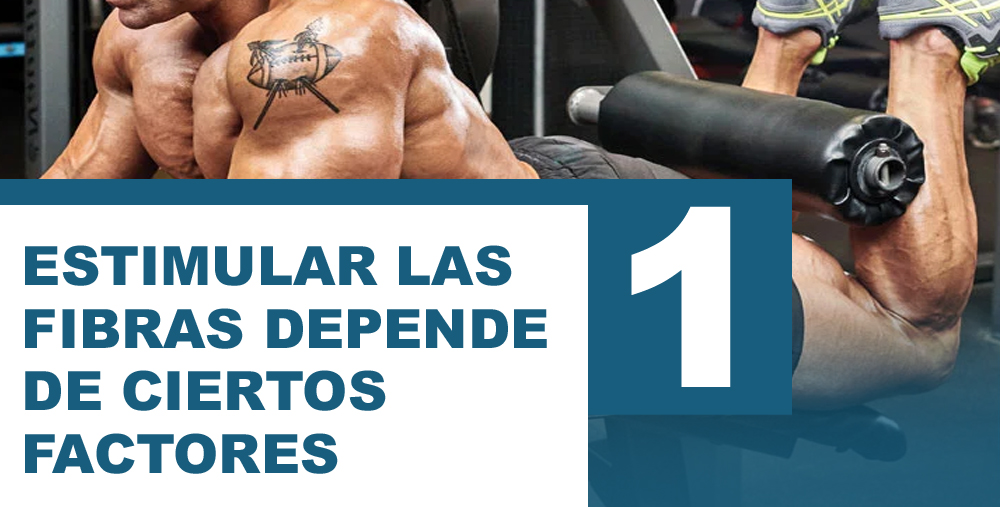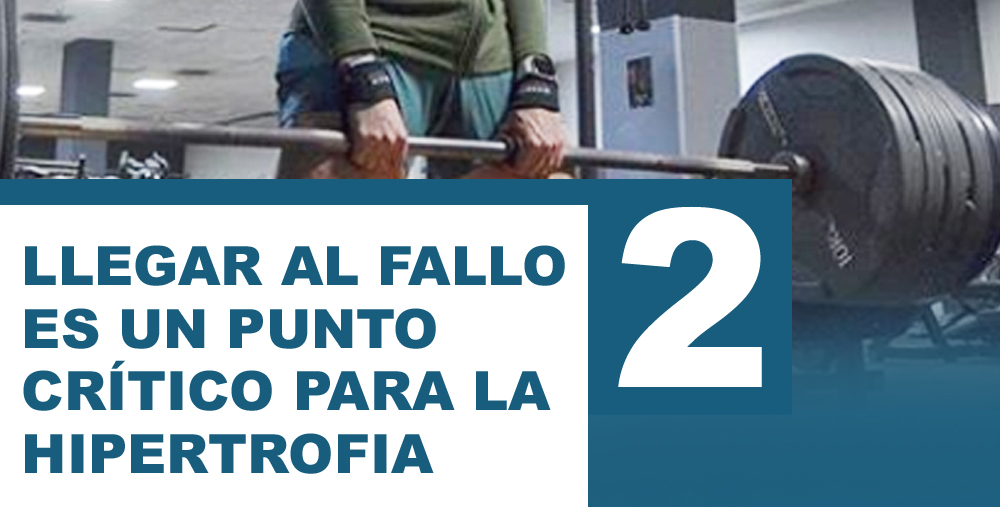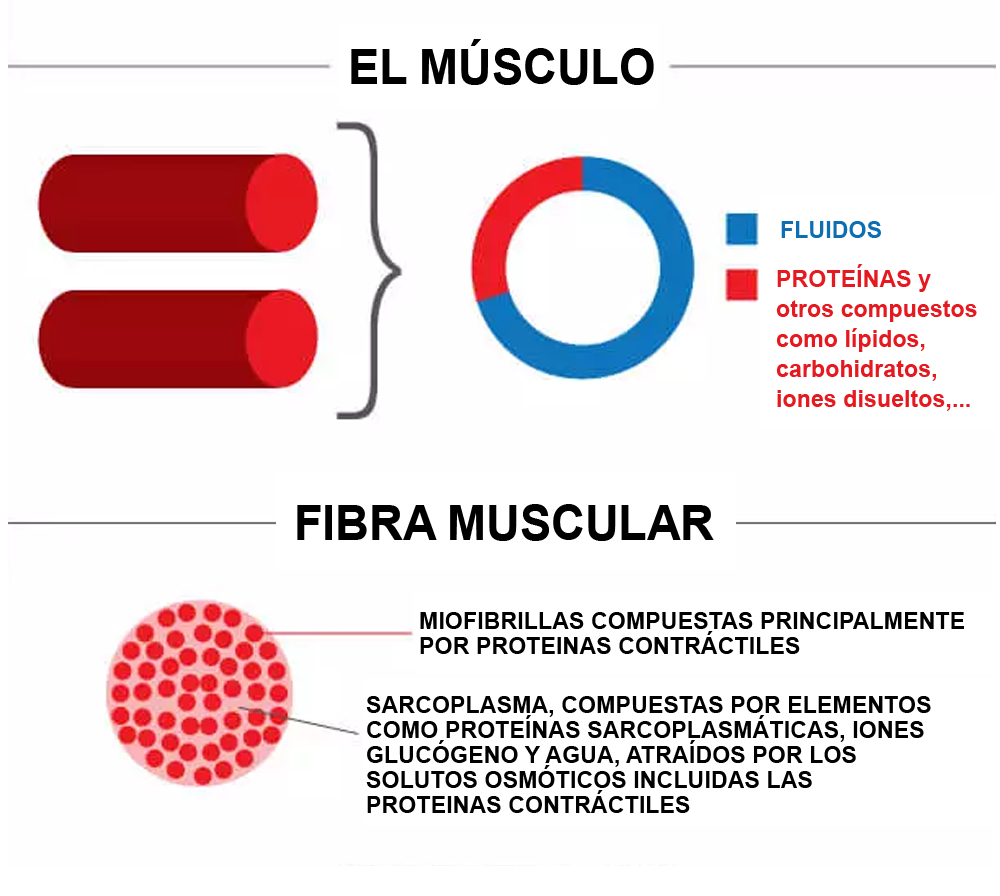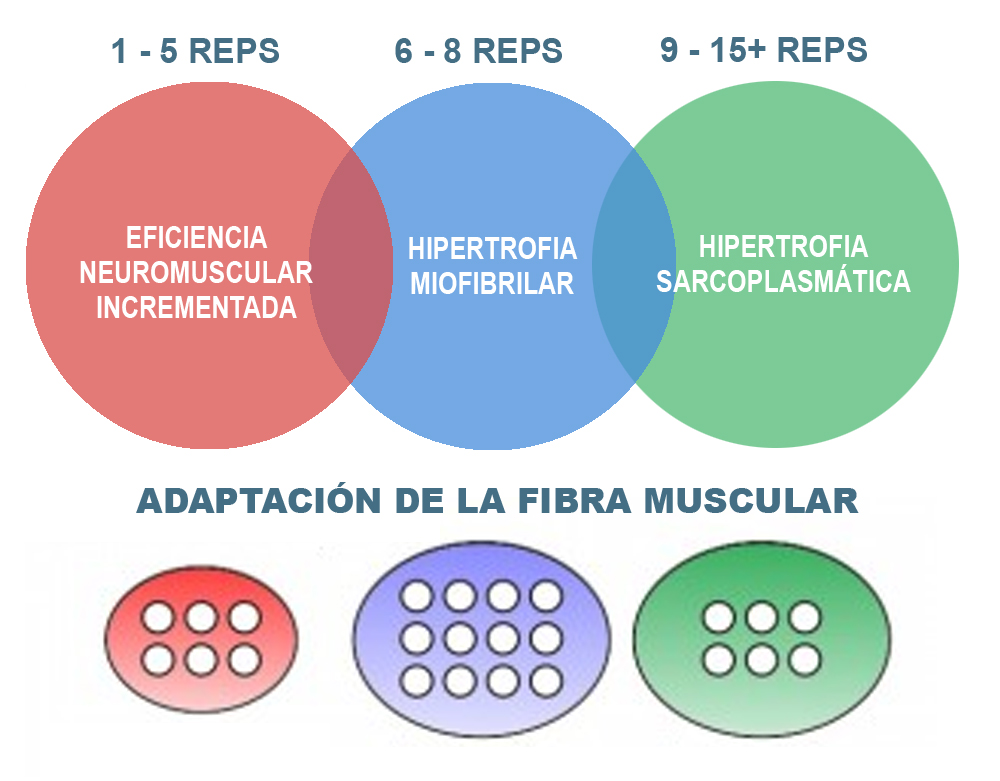When we combine science and reality of how muscular hypertrophy occurs , we need to clarify things as Roberto Castellano does.
muscle hypertrophy refers to the increase in the transverse diameter of the muscle fibers, which implies a greater quantity of contractile actin and myosin filaments, which to a greater degree is generated thanks to protein synthesis.
Muscle hypertrophy according to the definition is an increase and growth of muscle cells and this is achieved through exercise.
Recapping things, there are two types:
- Myofibrillar / Sarcomérica: growth of muscle contraction parts.
- Sarcoplasmic: increased storage of muscle glycogen.
Which type to focus on depends on your fitness goals, as sarcomeric training will help with strength and speed, while sarcoplasmic growth helps give your body more sustained energy for endurance events. athletic.
The way you lift a weight or exercise with a resistance-producing accessory (including your body weight) will determine how your muscles grow and change; Obviously reaching muscular hypertrophy requires knowledge.

For example, you can build muscle tone with a lighter weight, but it will require a large number of repetitions to improve the efficiency of the muscle fibers.
Unless you perform a series of repetitions to the point of fatigue or technical / muscle failure, this style of training will not achieve much muscle definition.
On the other hand, using a heavy weight is an effective way to stimulate the growth and definition of muscle fibers, it is also a more efficient way to train, but obviously periodization comes into play here, which requires periodic modifications of volume or intensity.
Muscular hypertrophy : how to develop it?
To build muscle through lifting weights or using accessories, you need both mechanical damage and metabolic fatigue.
When you lift a heavy weight, the contractile proteins in the muscles must generate force to override the resistance provided by the weight.
In turn, this can result in structural damage to the muscles.
- Mechanical damage to muscle proteins stimulates a repair response in the body.
- Damaged fibers in muscle proteins result in increased muscle size.
Mechanical fatigue occurs when muscle fibers deplete their available supply of ATP, an energy component that helps muscles contract. By not continuing to fuel muscle contractions or by no longer being able to lift the weight properly, this also leads to muscle hypertrophy or increased lean mass.
Both mechanical damage and metabolic fatigue are important in achieving muscle hypertrophy.
You don’t need to work your muscles to the point of what is called “failure,” which means you can’t follow a rep to get the results you want.

On the other hand, a 2010 study found that to obtain maximum gains, there needs to be significant metabolic stress on the muscles, in addition to a moderate degree of muscle tension (1).
In this study, the researchers found that exercises involving shortening (concentric) movements at fast to moderate speeds for 1-3 seconds and lengthening (eccentric) at slower speeds (2-4 seconds) are very effective .
An example of a concentric movement is lifting the weight during a bicep curl toward the shoulder; returning to the starting position would be eccentric, but this concept is very clear to both beginners and advanced.
Muscular hypertrophy : how often to work?
The frequency with which you need to exercise to achieve muscle hypertrophy also depends on your goals and in this biological individuality plays a main role, because each body is different.
However, there are divisions you can do:
- Training (especially heavy weights) three days a week: This allows you one day between sessions for your muscles to recover. Here, recovery is essential for muscle growth.
- Train each muscle group only two days a week, depending on your current fitness level.
- Or, you can alternate between upper body training and lower body training on different days. This allows you to work different muscles while giving yourself time to rest and recover.
Regarding training frequency, let’s recap a bit. Here we show you a video by Raúl Carrasco, who gave us a summary on this topic that is, in addition to being controversial, crucial for obtaining results.
Now, regardless of all this that can be generated depending on each training program, let’s delve a little more about muscle hypertrophy .
The muscular hypertrophy sarcomérica
Myofibrils are essentially bundles of myofilaments (the contractile parts of a muscle, the parts that pull); They are found in every fiber of skeletal muscle.

Each muscle cell contains many myofibrils. Myofibril or sarcomeric hypertrophy occurs due to an overload stimulus (lifting more than your body is used to) that applies trauma to individual muscle fibers.
Your body treats this as an injury and, as such, overcompensates during the recovery process by increasing the volume and density of the myofibrils so that the “injury” does not occur again.
This is one of the reasons why you must maintain the overhead to keep making profits.
Sarcomeric hypertrophy generally occurs within the range of 6 to 8 repetitions (using a weight that you can only complete 6 to 8 repetitions per set).
This type of muscle hypertrophy occurs when myofibrils increase (increase in muscle fiber and the amount of muscle fiber).
This type of muscle is extremely dense and hard; a muscle consisting primarily of sarcomeric hypertrophy feels as hard as a rock in a contracted state. This increases your strength exponentially as the amount of muscle fiber increases and the size of the muscle fiber increases.

The muscular hypertrophy sarcoplasmica
Sarcoplasm are the sources of energy and fluids that surround the myofibrils in muscle; includes elements such as ATP, glycogen, creatine phosphate, and water.
An increase in the size of the blood vessels that supply blood to the muscles can also be included in sarcoplasmic hypertrophy and is commonly known as capillarization.
This occurs in the same way as myofibrillar hypertrophy, through overcompensating your body during the recovery phase, after your energy sources have been depleted during a workout.
In this instance, you must increase energy stores such as ATP and glycogen to avoid exhaustion during training.
In this type of muscle hypertrophy the sarcoplasm of the muscles (fluid within the cell membrane) increases.
There is no increase in the size of the myofibrils (muscle fiber) and no new myofibrils are created; the only thing that increases is the volume of sarcoplasm (fluid inside the cell) per cell and, it occurs in a range of 9/10 to 15 repetitions per series.
Any rep range above 15 reps per set will begin to work on the endurance capacity of your muscles and begin to turn into an aerobic exercise rather than an anaerobic one.
It should also be noted that any rep range between 1 and 5 per set increases the maximum strength of a repetition (or power) as your body adapts to the greater amount of weight used.
Here it is able to recruit almost all available muscle fiber, which makes you enter a state of neuromuscular efficiency. However, there are no size or endurance gains within the very low rep range.
The sarcomeric training
Strength training with more than 80% of your 1RM and repetitions in the 3-8 range with 2-4 minutes rest produce the largest changes in myofibrillar / sarcomeric volume and density.
Therefore, if you want to achieve sarcomeric muscle hypertrophy , you must lift heavy weights.
- The heavier the weights you lift, the more muscle fibers are recruited and, in turn, are damaged
- However, it is recommended to keep repetitions between 3-5 as a minimum, since it is mainly neuromuscular adaptations that improve strength (2) (Zatsiorsky, 1995).
In fact, doing low repetitions is essential to achieve maximum growth, as you reach those adaptations that every bodybuilder wants. (3) (Charles Poliquin 1997).
The sarcoplasmic training
Sarcoplasmic muscle hypertrophy is achieved through what is known as fatigue training.
Fatigue training consists of training at an intensity of approximately 75% of your 1RM with repetitions in the range of 9 / 10-15 and short rest periods of 45-90 seconds.
It is known as fatigue training, since it quickly and directly consumes much of the energy stored in the muscle cells and fatigue the muscles.
In this scenario, when choosing the number of series for your workouts, you must take into account the time under tension.
- A minimal amount of time under tension is required for muscle hypertrophy to occur.
- Because of this, it is generally required to complete more total sets for a strength training routine than a higher rep fatigue training routine.
In fatigue training to achieve muscle hypertrophy , the time under tension must be greater than the immediate energy available.

In this case, the most immediate source of energy for short term anaerobic exercise is ATP and creatine phosphate stores, however these are very short term and as such will be depleted in 7-10 seconds.
After this, your body will break down glycogen for energy, which will produce lactic acid (it will produce that burn you feel).
Therefore, you should maintain a time under tension greater than 10 seconds per set in fatigue training and, this can be achieved by including slower repetitions, or methods such as supersets of the same muscles, it is an excellent way to achieve it.
To further deepen this passionate topic, take a look at this introductory video developed by Roberto Castellano, who also talks about satellite cells.
Repetitions and hypertrophy types
There is a spectrum through which muscular hypertrophy of myofibrils and sarcoplasmic hypertrophy occurs, which we have already talked about, but summarizing:
- 1-5 reps: leads to a maximum increase in relative strength and myofibril recruitment.
- 6-8 repetitions: produces the best medium between myofibrils and sarcoplasmic hypertrophy.
- 9-12 repetitions: increases sarcoplasmic hypertrophy to the maximum.
- More than 15 repetitions: move into the muscular endurance range where hypertrophy is slowly gained.
The damage of the myofibrils will not stop occurring in more than 12 repetitions, but will be to a lesser degree and with less muscle fiber recruited than in lower repetitions.
Put it this way, why would you want to train in a rep range where you don’t get maximum gains in sarcoplasmic or sarcomeric hypertrophy?
The point is that when you can train both to their maximum potential, without diminishing the gains of the other muscle hypertrophy , you would reach efficiency.
Okay, so sarcomeric hypertrophy is best achieved through strength training and sarcoplasmic hypertrophy through fatigue training. What is the best way to achieve both?
To answer the question, you can get advice from one of two giants of bodybuilding and this depends on each one.


